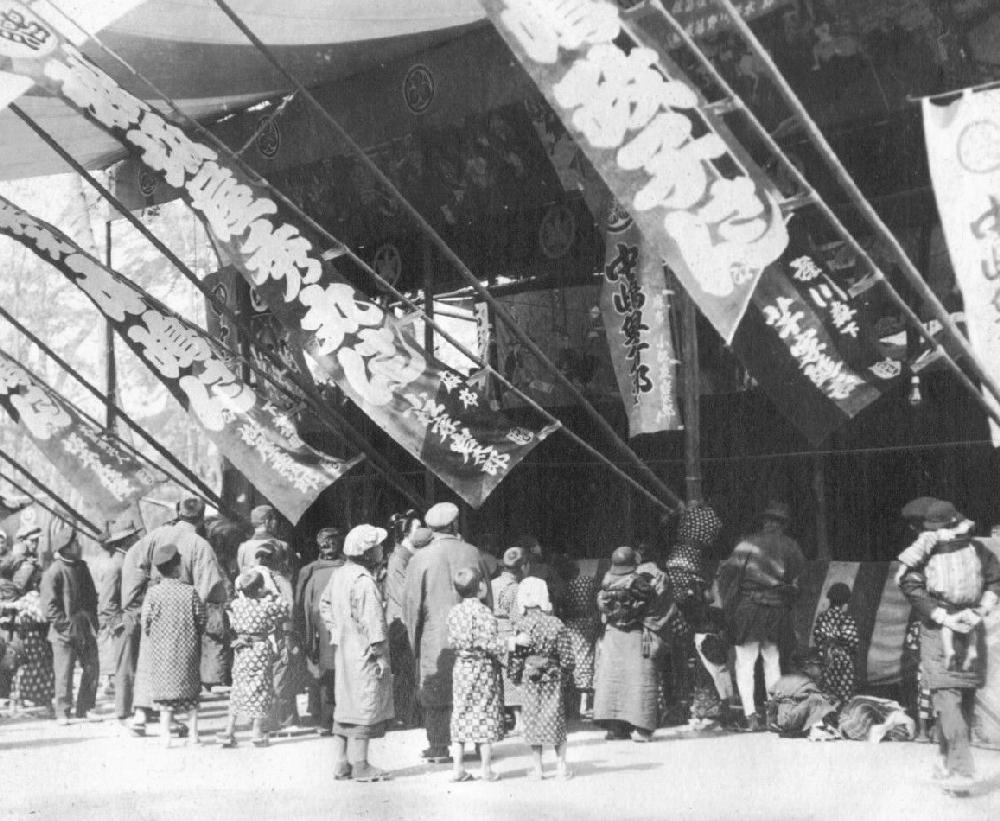
Japanese Economy: Inter-War Era

Figure 1.--Here we see a market, we think in Tokyo, about 1920. Unfortunately we do not know what the text on the banners says. Japan was the only industrial society in Asia, although a still very traditional society. And it it is only in the 1920s that major advances were made in building the heavy inustry that would give the country the capability of launching the Pacific War. It was an industrial base a fraction of American industry, but it was enough to prepare for a short war of conquest as long as America severely limited military expenditures.
|
|
It was in the Inter-War Era that Japan developed the heavy industry need to fight the Pacific War. It was an industrial base a fraction of American industry, but it was enough to prepare for a short war of conquest as long as America severely limited military expenditures. The Japanese World War I export boom burst with the end of World War I in Europe (November 1918). It took about a year for the bubble to be burst because it took some time for European industry to convert to peace time production. The crash finally came (1920). A post-War recession ensued. Prices of Japanese manufactured commodities (suh as cotton yarn and silk collapsed, The stock market fell by more than half. In the recession, problems like the lak of competition and the overcapcity developing during the war-time boom became all too apparent. Many small businessmen who expanded during the boom and got rich (narikin) but over extended were forced into bankrupcy. Throughout the 1920s, Japan experienced recessions and banking crises. There were several recessions, but they were mild and short lived. Very serious bank runs occurred (1927). The overall economy slowed, especially compared to the World War I bubble period. There was, however, no serious decline in production. Domestic demand was not vigorous, but was stable. Foreign demnd was a different matter. Declining foreign sales ed into the desire to expand the Empire and the creation of a solid captive market. This of coirse ponted to China. The persistent trade defecits that dominated before the war resumed after the war, but were not a serious problem because of the sizeable gold reserves that accumulted during the War. The business climate was not terrible, but it was very different than he Roaring Twenties underway in America. The Government became concerned about a prolonged period of recesion. In the era before quantative easing, the Government had two basic options. One the Government could rescue weak, endebted compnies and banks or two shit down the weak companies to build a stringer, solid economy. The Government opted for short-term stability ad decided to support the weak companies. The Bank of Japan provided emergency funds to hard pressed banls and compaies that were close to failing. The goal was to prevent more bankruptcies and unemployment. This policy prevented serious exonomic paoin in the 20s, bu asone econist reports, 'implanted a time bomb in the Japanese economy which exploded several years later.' [Ohno, p. 103.] Despite the economic problems of he 1920s, Japan made huge progress in developing heavy industries and chemical industry. This was when Japan made huge profress in steel, chemicals, machinery, and artifical silk (rayon). This began during World War I when European exports were cut. Then durng the 1920s government support (financing, prders, and tariff protection), electrification, acquisition of foreign technology, and industrial linkages. [Ohno, p. 104.] Involved in this process was the zaibatsus which began to form during the Meiji Era as the Government began granting special rights to private, family businesses in return for their promotion of government objectives. This corporate structure was essentially a two-headed entity. Business and government were superficially eparate entities but in practice were parts of the same structure. New heavy industrial zaibatsu emerged as industrial giants such as Nissan, Nicchitsu, and Mori adding to the existing zaibatsu such as Mitsui and Mitsubishi. [Ohno, p. 104-05.] Japan was rocked by the Great Depression of the 1930s. Japan was especially impacted because it was so export oriented. And Government officials pursued disasterous policies like fixating on the gold standard and austerity. The result was rising unemployment and serious deflation. Japan thus experiencded social instability which helped the military expand its control of Japan, similar to the development of European Fascism. Japan gained a quick victory in Manchuria, but when it invaded Chinaeoper (1937) they ahieved military success, but were unable to defeat the Chinese Nationalists. Five years of war in China greatly strained the Japanese economy.
Sources
Ohno, Kenichi. Th Economic Developmnt of Japan: The Path Traveled by Japan as aeveloping Country (GRIPS: 2006).
CIH

Navigate the Children in History Website:
[Return to the Main Japanese economics page]
[Return to the Main Japanese page]
[Return to the Main Asian country economics pages]
[Return to the Main economics country page]
[Return to the Main Economics page]
[Activities]
[Chronology]
[Clothing styles]
[Countries]
[Debate]
[Economics]
[Garment]
[Gender]
[Hair]
[History]
[Home trends]
[Literary characters]
[School types]
[Significance]
[Transport and travel
[Uniform regulations]
[Year level]
[Other topics]
[Images]
[Links]
[Registration]
[Tools]
[Return to the Historic Boys' School Home]
Created: 4:38 PM 7/25/2017
Last updated: 4:38 PM 7/25/2017



